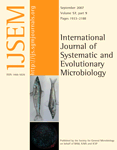Nomenclature is the set of rules and conventions which govern the names of taxa. It is the application of formal rules for naming organisms. Classification is the grouping of organisms into progressively more inclusive groups based on phylogeny and phenotype. Despite there being no official and complete classification of prokaryotes, the names (nomenclature) given to prokaryotes are regulated by the International Code of Nomenclature of Bacteria (Bacteriological Code), a book which contains general considerations, principles, rules, and various notes and advises in a similar fashion to the nomenclature codes of other groups .

International Journal of Systematic and Evolutionary Microbiology (IJSEM)
The IJSEM covers the naming of new bacteria and how they fit evolutionarily.
The taxa which have been correctly described are reviewed in Bergey's manual of Systematic Bacteriology, which aims to aid in the identification of species and is considered the highest authority. An online version of the taxonomic outline of bacteria and archaea is available. Taxonomic names are written in italics (or underlined when handwritten) with a majuscule first letter with the exception of epithets for species and subspecies. Despite it being common in zoology, tautonyms (e.g. Bison bison) are not acceptable and names of taxa used in zoology, botany or mycology cannot be reused for bacteria (Botany and Zoology do share names).
For bacteria, valid names must have a Latin or Neolatin name and can only use basic latin letters (w and j inclusive, see History of the Latin alphabet for these), consequently hyphens, accents and other letters are not accepted and should be translitterated correctly (e.g. ß=ss). Ancient Greek being written in the Greek alphabet, needs to be translitterated into the Latin alphabet.
Many species are named after people, either the discoverer or a famous person in the field of microbiology, for example Salmonella is after D.E. Salmon, who discovered it (albeit as "Bacillus typhi"). For the generic epithet, all names derived from people must be in the female nominative case, either by changing the ending to -a or to the diminutive -ella, depending on the name. For the specific epithet, the names can be converted into either adjectival form (adding -nus (m.), -na (f.), -num (n.) according to the gender of the genus name) or the genitive of the latinised name.
Many species (the specific epithet) are named after the place they are present or found (e.g. Borrelia burgdorferi). Their names are created by forming an adjective by joining the locality's name with the ending -ensis (m. or f.) or ense (n.) in agreement with the gender of the genus name, unless a classical Latin adjective exists for the place. However, names of places should not be used as nouns in the genitive case.
For the Prokaryotes (Bacteria and Archaea) the rank kingdom is not used (although some authors refer to phyla as kingdoms). If a new or amended species is placed in new ranks, according to Rule 9 of the Bacteriological Code the name is formed by the addition of an appropriate suffix to the stem of the name of the type genus. For subclass and class the reccomendation from is generally followed, resulting in a neutral plural, however a few names do not follow this and instead keep into account Graeco-Latin grammar (e.g. the female plurals Thermotogae, Aquificae, and Chlamydiae, the male plurals Chloroflexi, Bacilli, and Deinococci, and the Greek plurals Spirochaetes, Gemmatimonadetes, and Chrysiogenetes).
Phyla are not covered by the Bacteriological Code, however, the scientific community generally follows the Ncbi and Lpsn taxonomy, where the name of the phylum is generally the plural of the type genus, with the exception of the Firmicutes, Cyanobacteria, and Proteobacteria, whose names do not stem from a genus name. The higher taxa proposed by Cavalier-Smith are generally disregarded by the molecular phylogeny community (vide supra).